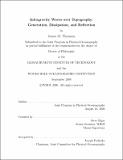Infragravity waves over topography: generation, dissipation, and reflection
Author(s)
Thomson, James M. (James McArthur)
DownloadFull printable version (3.301Mb)
Other Contributors
Woods Hole Oceanographic Institution.
Advisor
Steve Elgar.
Terms of use
Metadata
Show full item recordAbstract
Ocean surface infragravity waves (periods from 20 to 200 s) observed along the southern California coast are shown to be sensitive to the bottom topography of the shelf region, where propagation is linear, and of the nearshore region, where nonlinearity is important. Infragravity waves exchange energy with swell and wind waves (periods from 5 to 200 s) via conservative nonlinear interactions that approach resonance with decreasing water depth. Consistent with previous results, it is shown here that as waves shoal into water less than a few meters deep, energy is transfered from swell to infragravity waves. In addition, it is shown here that the apparent dissipation of infragravity energy observed in the surfzone is the result of nonlinear energy transfers from infragravity waves back to swell and wind waves. The energy transfers are sensitive to the shallow water bottom topography. On nonplanar beach profiles the transfers, and thus the amount of infragravity energy available for reflection from the shoreline, change with the tide, resulting in the tidal modulation of infragravity energy observed in bottom-pressure records on the continental shelf. The observed wave propagation over the shelf topography is dominated by refraction, and the observed partial reflection from, and transmission across, a steep-walled submarine canyon is consistent with long-wave theory. A generalized regional model incorporating these results predicts the observed infragravity wave amplitudes over variable bottom topography.
Description
Thesis (Ph. D.)--Joint Program in Physical Oceanography (Massachusetts Institute of Technology, Dept. of Earth, Atmospheric, and Planetary Sciences; and the Woods Hole Oceanographic Institution), 2006. This electronic version was submitted by the student author. The certified thesis is available in the Institute Archives and Special Collections. Includes bibliographical references.
Date issued
2006Department
Joint Program in Physical Oceanography; Woods Hole Oceanographic Institution; Massachusetts Institute of Technology. Department of Earth, Atmospheric, and Planetary SciencesPublisher
Massachusetts Institute of Technology
Keywords
Joint Program in Physical Oceanography., Earth, Atmospheric, and Planetary Sciences., Woods Hole Oceanographic Institution.